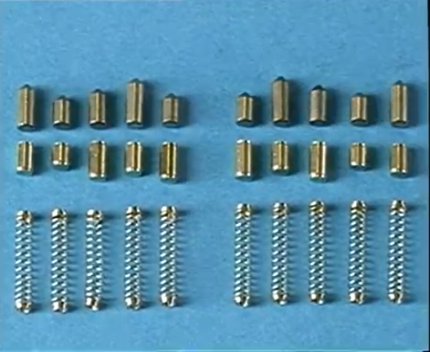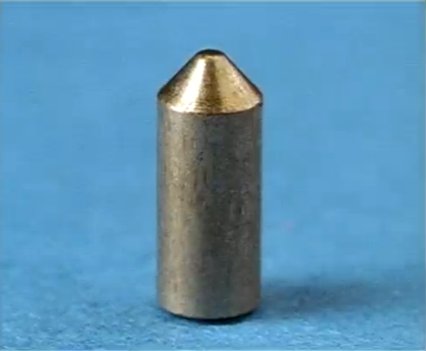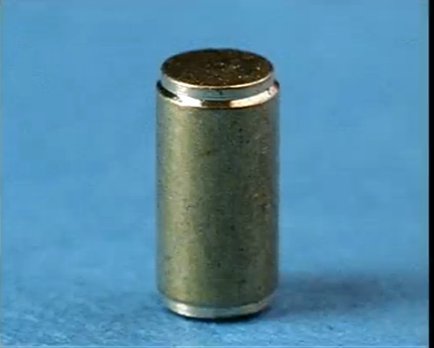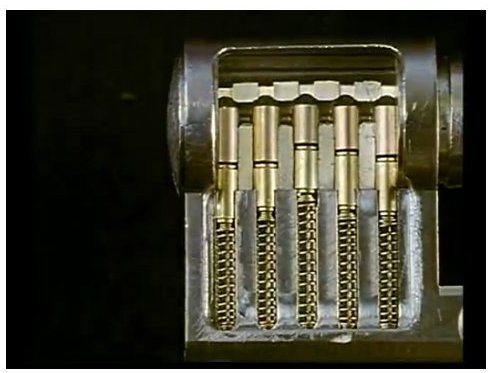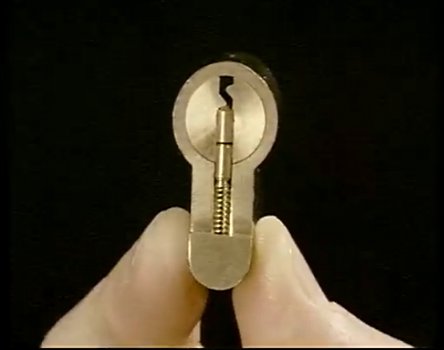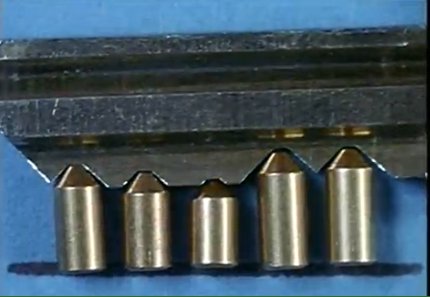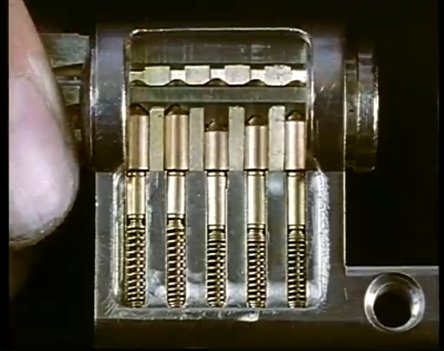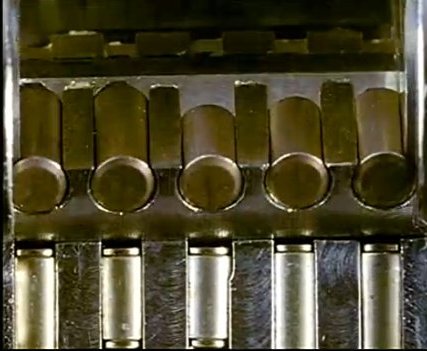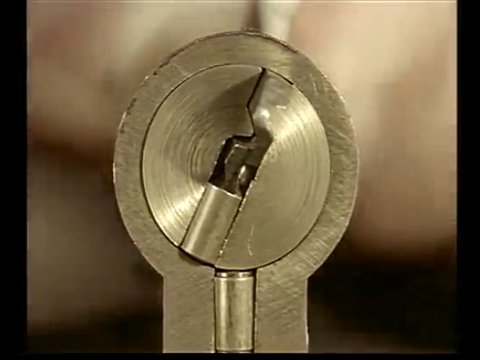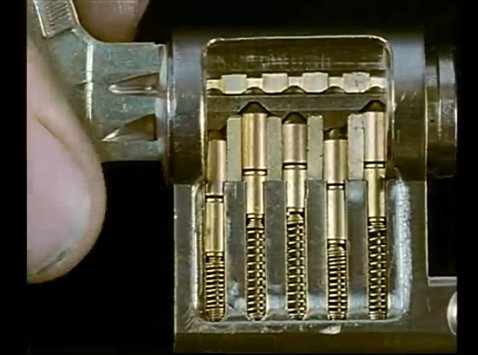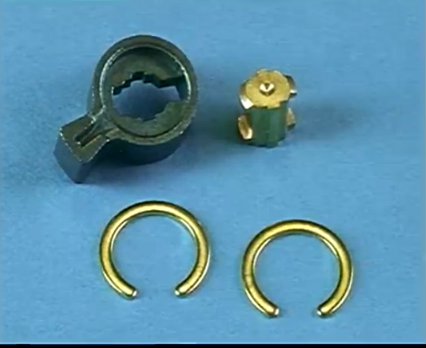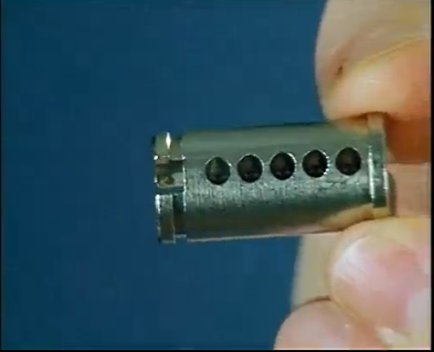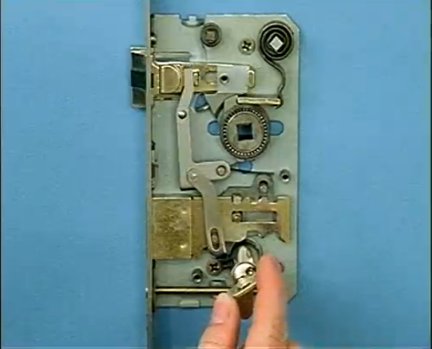Project:Lockpicking/Inside lock: Difference between revisions
From London Hackspace Wiki
(Inside a lock -- first version.) |
mNo edit summary |
||
| (12 intermediate revisions by 4 users not shown) | |||
| Line 5: | Line 5: | ||
==Overview of inside a lock== | ==Overview of inside a lock== | ||
[[File:lock-inside-springs-pins.jpg|border|center|text bottom]] | [[File:lock-inside-springs-pins.jpg|border|center|text-bottom]] | ||
<center> | <center>The inside a lock is made of the following: 10 springs (under much tension), 10 bottom pins and 10 top pins. On each side of the lock there would be five pins (some locks have more than five pins on each side.)</center> | ||
<br> | <br> | ||
[[File:Locks-top-pin.jpg|border|center|text bottom|''Top Pin'']] | [[File:Locks-top-pin.jpg|border|center|text-bottom|''Top Pin'']] | ||
<center>Here a view of the top pin. The top pin varies in length but it usually the same form.</center> | <center>Here a view of the top pin. The top pin varies in length but it usually the same form.</center> | ||
| Line 17: | Line 17: | ||
<br> | <br> | ||
[[File:Lock-inside-pin.jpg|border|center|text bottom|''Bottom Pin'']] | [[File:Lock-inside-pin.jpg|border|center|text-bottom|''Bottom Pin'']] | ||
<center>Here is a view of the bottom pin. The bottom pin varies in length like the top pin, however, the bottom pin have more variations in form than the top pin. This pin is what we call a <i>spool</i> pin. These variations make lockpicking more difficult rather than the pin just having a straight form since these pins get stuck in the lock much easier than pins just with a straight form.</center> | <center>Here is a view of the bottom pin. The bottom pin varies in length like the top pin, however, the bottom pin have more variations in form than the top pin. This pin is what we call a <i>spool</i> pin. These variations make lockpicking more difficult rather than the pin just having a straight form since these pins get stuck in the lock much easier than pins just with a straight form.</center> | ||
| Line 27: | Line 27: | ||
<br> | <br> | ||
[[File:Lock-with-pins-closed.jpg|border|center|text bottom|''Pins in a lock'']] | [[File:Lock-with-pins-closed.jpg|border|center|text-bottom|''Pins in a lock'']] | ||
<center>Here we can see the top pins, the bottom pins and the springs in a lock. At the present state, the lock is locked and cannot be opened since the pins are blocking the <i> | <center>Here we can see the top pins, the bottom pins and the springs in a lock. At the present state, the lock is locked and cannot be opened since the pins are blocking the <i>shear line</i>. In order for a lock to open, all pins must be aligned at the shear line.</center> | ||
<br> | <br> | ||
[[File:Lock-behind-closed.jpg|border|center|text bottom|''View from behind, closed'']] | [[File:Lock-behind-closed.jpg|border|center|text-bottom|''View from behind, closed'']] | ||
<center>Here we have yet another view of the top pin, bottom pin and the spring. Here we can see clearly that the bottom pin is blocking the | <center>Here we have yet another view of the top pin, bottom pin and the spring. Here we can see clearly that the bottom pin is blocking the shear line and thus the lock cannot open.</center> | ||
<br> | <br> | ||
| Line 43: | Line 43: | ||
<br> | <br> | ||
[[File:Lock-key-pins.jpg|border|center|text bottom|''Key with the right code'']] | [[File:Lock-key-pins.jpg|border|center|text-bottom|''Key with the right code'']] | ||
<center>In order for a lock to open, all pins must be aligned on the | <center>In order for a lock to open, all pins must be aligned on the shear line. This is the function of the key. The cuts in the key correspond to the length of the pins inside the lock. This image shows five top pins aligned neatly to the key above.</center> | ||
<br> | <br> | ||
[[File:Lock-key-sheerline.jpg|border|center|text bottom|''right key inside lock, sheer line'']] | [[File:Lock-key-sheerline.jpg|border|center|text-bottom|''right key inside lock, sheer line'']] | ||
<center>In this image, we can see that the right key is inside the lock. We see that all the pins are aligned neatly. We can see that there is a space between the top and bottom pins which we call the <i> | <center>In this image, we can see that the right key is inside the lock. We see that all the pins are aligned neatly. We can see that there is a space between the top and bottom pins which we call the <i>shear line</i>. In the present state, the lock can turn and open since no pins are blocking the movement of the lock.</center> | ||
<br> | <br> | ||
[[File: | [[File:Locks-shearline-open.jpg|border|center|text-bottom|''Lock opened at the shear line'']] | ||
<center>This image shows us the lock opening since all the pins are neatly arranged at the shear line. The key has two functions: 1) to align the pins at the shear line and 2) with tension, to turn the lock open.</center> | |||
<center>Here we see the right key in the lock and we see that all pins are aligned neatly on the | <br> | ||
[[File:Lock-behind-key.jpg|border|center|text-bottom|''View from behind with right key'']] | |||
<center>Here we see the right key in the lock and we see that all pins are aligned neatly on the shear line and that there are no pins blocking the lock. Thus, the lock can turn open</center> | |||
<br> | <br> | ||
== | ==Example of the Wrong Key in a Lock== | ||
<br> | <br> | ||
[[File:Lock-wrong-key.jpg|border|center|text bottom|''Wrong key in the lock'']] | [[File:Lock-wrong-key.jpg|border|center|text-bottom|''Wrong key in the lock'']] | ||
<center>In this image, a wrong key is in the lock. You can see clearly that the | <center>In this image, a wrong key is in the lock. You can see clearly that the shear line is blocked. The shear line is blocked by either the top pin or the bottom pin.</center> | ||
<br> | <br> | ||
| Line 91: | Line 96: | ||
[[File:Door-and-lock.jpg|border|center|text bottom|"How a lock opens a door"]] | [[File:Door-and-lock.jpg|border|center|text bottom|"How a lock opens a door"]] | ||
<center>We see here how the lock moves a lever which disengages the lock so that the door can open. It should be noted this design has not changed very much since the 19th century when first designed.</center> | <center>We see here how the lock moves a lever which disengages the lock so that the door can open. It should be noted this design has not changed very much since the 19th century when it was first designed in Germany.</center> | ||
<br> | <br> | ||
[[Category:Guides]] | |||
Latest revision as of 21:38, 28 May 2013
Inside a Lock
Have you ever wondered (or cared) what is inside a lock? How does a lock close and how does a lock open? For this example, we have taken a "eurocylinder" The eurocylinder is the most used door lock in Europe.
Overview of inside a lock
The Pins Inside the Lock
Function of the key inside the lock
Example of the Wrong Key in a Lock
Other parts of the Euro Cylinder
How does the lock open the door?
